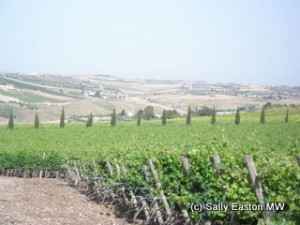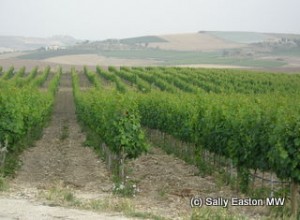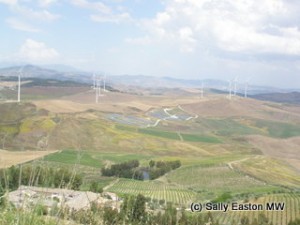Sicily's own nero d'avola

Baglio del Cristo di Campobello
Some countries have an adopted signature grape variety – carmenere in Chile, pinotage in South Africa, malbec in Argentina. Sicily has nero d’avola.
Though Sicily is part of Italy’s vineyard, this island of delicious food wealth has more vineyard than entire countries – more than both Chile and South Africa, so it’s not so strange to make such a comparison. And where pinotage and carmenere both account for around 8% of South Africa’s and Chile’s vineyard respectively, nero d’avola occupies 16% of Sicily’s vineyard. If the everyday white catarratto is excluded, much of which is used in the production of fortified wine Marsala or to make grape concentrate, then nero d’avola would account for a quarter of Sicily’s 116,000 hectares of vines.
Nero d’Avola, which literally translates as ‘black of Avola’ originates from Avola, in the south eastern tip of Sicily, about 25km south of Siracusa. Here, and around Pachino, a further 25km south, and almost at sea level, produce nero d’avola in a meaty, muscular style.
The challenge for nero d’avola (as for other grape varieties the world over), which is grown all over the island, is that quality ranges from the ordinary to the extraordinary, and because it is so widespread, there is little incentive to create sub-regional specialisms for the variety. But quality and repute are growing, both when nero d’avola is vinified alone, or blended – traditionally with frappato in Cerasuolo di Vittoria, or more recently with shiraz/syrah, as this international interloper finds some excellent expression on the island.
The altitudinous range of nero d’avola brings its own stylistic variation, from the muscle of sea level Pachino to a certain degree of elegance and perfume at around 750m up in the Madonie mountain ranges. Alcohol in the finished wine can be up to 2% lower at this altitude, and it is at these heights that Feudi Montoni has some of the oldest source material of nero d’avola.
Back at sea level, Federico Curtaz of Tenuta di Fessina on Etna, makes a nero d’avola from Noto (near Avola). He said nero d’avola “has high acidity, like a Piemontese barbera, often with 6.5g/l acidity [expressed as tartaric] at the end of malolactic fermentation.” Even though, in Noto “with 42°C we are not oppressed by heat, because there is a fresh wind” from the Mediterranean Sea.

Masseria del Feudo
Nero d’avola arguably reaches its most famous guise west of Ragusa, in Sicily’s only DOCG (since 2005), Cerasuolo di Vittoria. Here, nero d’avola is blended with between 30 and 50% of the light, lifting, fresh frappato. It’s frappato that adds acidic lift to nero d’avola in this warm to hot southerly part of the island. Avide’s Marco Calcaterra said “frappato is one of the first [grape varieties] that has body, but the last to reach ripeness. On average its acidity will be 6-7 g/l [tartaric]. And it will lose about 0.5g/l in the winemaking.” Frappato’s lightness and freshness is just the thing to soften the muscle of nero d’avola.
Even so, experimentation with barrique ageing over the last quarter of a century has led to a more serious, full-bodied style of wine in this region. At Valle dell’Acate, Francesco Ferreri explained they started maturing nero d’avola in barrique, and have more recently moved to 500-litre French wood casks for a softer impact, as, he said, the theme for Cerasuolo di Vittoria DOCG, “is an elegant wine rather than powerful wine.”
The warm climate in this south-central part of Sicily “gives fruity, clean and balanced” wines he added, and the regular winds coming up the Dirillo valley from the Mediterranean Sea to the west help keep the fruit healthy. The resulting nero d’avola is “big, but less big than from Pachino, because the tannins are sweet and mature.”
Further west, parts of Agrigento province are growing in repute, both near the coast and high up in the hills. Just eight kilometres from the sea, Baglio del Cristo di Campobello, devotes 60% of their vineyard area to nero d’avola. “There’s always a breeze” said Carmelo Bonetta, “and it can be 35 to 40°C during day, then it can be 20 to 22°C at night” which helps to restore a little freshness to the atmosphere.
A little further inland, at Masseria del Feudo, brother and sister team Francesco and Carolina Cucurullo have 18 hectares of vineyard on their 110 ha property of mixed agriculture which their family has been cultivating since 1860. Nero d’avola joins syrah, ansonica, grillo and chardonnay. With some 450m elevation, Francesco explained there is “up to 15°C day-night temperature difference during ripening. Days can be up to 35°C, with 20°C at night.” This variation helps retain some of the grapes’ natural acidity, as does their picking a few days before full, sugar-sweet ripeness.

Feudo Montoni
Yet it is at even greater altitude, in the northerly extremity of Agrigento province, between 500 and 750m above sea level, that some of the most elegant and perfumed expressions of nero d’avola exist. And just a handful of producers work in these remote Madonie hills. It is here that the 380 hectare vineyard of the Regaleali estate of Tasca d’Almerita is found, and Guiseppe Tasca explained “this area gives more austere, not so explosive fruit, with a more velvety texture, more acidity, and more sternness.” Little wonder given that ripeness here occurs a month later than near the coast.
At neighbouring Feudo Montoni, Fabio Sireci claims a unique clone of nero d’avola – the vrucara clone. He said “Giacomo Tachis [who spent time working with Sicily’s Istituto Regionale della Vite e del Vino] likes the vrucara clone. Tachis was looking for true nero d’avola, and he thought mine could be one of the oldest and purest, for its age and isolation”, adding, of the vines his father had propagated, “Tachis said our nero d’avola has more acid, it’s more like a pinot noir,” which is a huge style change from the mighty, muscular, marine nero d’avolas of Pachino.
Wine tasting, in situ, June 2011
Single varietal nero d’avola
Tenuta di Fessina, Ero, nero d’avola IGT Sicilia, 2009 €13
Bright and purple hue. Nose a bit reticent, palate fresh, elegant tannin frame, silky smooth, blackcurrant and loganberry in fresh, fruit-focused style of wine.
Az. Vinicola Benanti, Il Drappo 2005, IGT Sicilia
Grown in Pachino, Val di Noto at sea level. Stainless steel fermentation then new barrels.
Attractive blackcurrant nose, then spicy, rich, sweet fruit to taste, nicely balanced with super fruit concentration and a tone of seriousness.
Azienda Vitivinicola Avide, Tre Carati 2006, nero d’avola. IGT
Half spends 18 months in barrel; the other half in stainless steel
Calcaterra “here you have the rudeness of nero d’avola, it misses the elegance of frappato”
Spicy, bramble, dark berry fruits, full body, big but not too muscley. Tasty and four square, does lack a bit of elegance, but it’s a nice big bold wine.
Valle dell’Acate, Il Moro, Nero d’Avola 2008, IGT €6.5
13.5%. Seven months in stainless steel. One year in bottle to give roundness to wine.
Red flower perfume. Supple and medium bodied. Sweet friuts, nicely textured in a fruity way, with sweet black pepper. Feel a bit of warmth at end, but a decent, uncomplicated wine.
Masseria del Feudo, Il Giglio Rosso, Nero d’Avola 2010, IGT €6
12.5%. 6 months in concrete.
Gentle red spices and redcurrant on the nose, light, primary fruit, unoaked. Nice juicy fruit,
medium deep colour. Lovely, straightforward wine, kind of soft and cuddly.
Baglio del Cristo di Campobello, Lu Patri 2008, IGP Sicilia ~€25
Dialect for the father. Nero d’avola as the father of all the indigenous vines in Sicily. 14 months in French barrique, one-third new. 14%, 5.5TA, pH3.42.
Smoky, liquorice stick, savoury nose. Palate with smooth and silky texture, dark berries, full bodied, hint savoury elements and lovely layers. Elegance with substance. Vg.
Baglio del Cristo di Campobello, Lu Patri 2009, IGP Sicilia
14%, 5.2TA, pH3.42. Not released at time of tasting.
Bright and crunchy red fruits with depth amidst the still integrating oak. At this stage the alcohol is showing again and the firm structure still needs to mellow with more bottle age.
Tasca d’Almerita, Lamuri 2009 IGT Sicilia €8-9
14%. Ten months in 2-3 year old oak.
Medium deep, bright red cherry colour, intense red and black cherry with sweet pepper spiciness on the nose and palate. Rich, sweet fruit, dry, refreshing texture.
Tasca d’Almerita, Rosso del Conte 2006 €30. Contea di Sclafani DOC
14%. Flagship wine from oldest vineyards, planted in 1959. New barrique for 18 months.
Smoky, aromatically tarry, lush, fat black fruits, smooth, quite powerful and well toned, not body-built. Big wine, dark brooding black fruits, liquorice, bramble, blueberry. Rich and succulent. Spicy and characterful.
Feudo Montoni, Nero d’Avola 2009 ~€12
13%. 40% in second passage oak.
Medium deep colour. Fragrant, tarry, elegant, with light redcurrants in mouth, a medium body, and lovely balance. Fresh, crunchy berry frits, just enough grip (without heat). Very nice. Long finish.
Feudo Montoni, Nero d’Avola Vrucara 2008 ~€20
13.5%. This has 8 months in new and second passage oak. Unfiltered. Wild ferment.
Deep colour, with hints of dark purple/blue. Aromatic charcoal smoke, with very smooth texture and sweet, brooding fruit. A real intensity of substance, with a fresh core. This is long, complex, layered, fresh and meditative; balanced, harmonious, and so, so, drinkable. And extremely good value at that price.
Cerasuolo di Vittoria
Azienda Vitivinicola Avide, Cerasuolo di Vittoria Classico 2008 ~€9
13.5%. 50% nero d’avola; 50% frappato. All stainless steel
Aromatic redcurrant and raspberry, soft and supple attack, sweet fruit, lush and medium-full body, gentle, fragrant spiciness on the palate core. Fresh and flavoursome. Smooth and with some elegance. And fresh finish.
Azienda Vitivinicola Avide, Barocco Cerasuolo di Vittoria Classico DOCG 2005
14%. 70% nero d’avola, 30% frappato. 2 ½ years in barrique, 1 ½ years in bottle.
Smoky, rich, blackcurrant, dense, sweet fruit, has fragrance mid palate.
Valle dell’Acate, Cerasuolo di Vittoria Classico DOCG 2008 ExC€6.5
13.5%. 70% nero d’avola, 30% frappato. In barrel for 8 months, some new.
Spicy nose, dark black hedgerow fruits, medium-full body, dark spiciness, but young-grainy tannin needs to integrate. Bit rustic; decent.
Syrah blends
Valle dell’Acate, Rusciano 2006, IGT Sicilia €8.60
90% syrah; 10% nero d’avola. Stainless steel,
Brambly with cardamom spice, supple, fresh and big-juiced. Full body, with fruit spiciness.
Valle dell’Acate, Tané 2005, IGT €15.6
15%. 80% nero d’avola; 20% syrah, part-raisined on the vine, press immediately for the juice. Ferment juice with skins/juice of nero d’avola for 15 days. Put in new barrique for 1 year, then in bottle for 2 years before release.
Rich, sweet, tarry and toasty nose, dense palate, with quite fragrant mid palate. Big and broad shouldered, with integrated alcohol, though I feel it a little at the end.
Baglio del Cristo di Campobello, CDC 2009, IGP Sicilia Rosso 2009 ~€10
~25% each of nero d’avola, syrah, cabernet sauvignon, merlot. No oak. 13.5%, 5.25TA, pH3.41.
Spicy rather than fruity nose, which comes through much more on the palate, with soft, crushed red berries and cherries, alongside soft spices.
Baglio del Cristo di Campobello, Adènzia 2009, IGP Sicilia ~€14
~80% nero d’avola, rest syrah and cabernet sauvignon. 14%, 5TA, pH3.48
Bright and sparky, with spicy, rich, dense sweet fruit. It’s more authentic somehow, and with a hint of chalky backbone. Good.
My research visit to Sicily in June 2011 was sponsored by the Sicilian Regional Institute for Viticulture and Wine.



